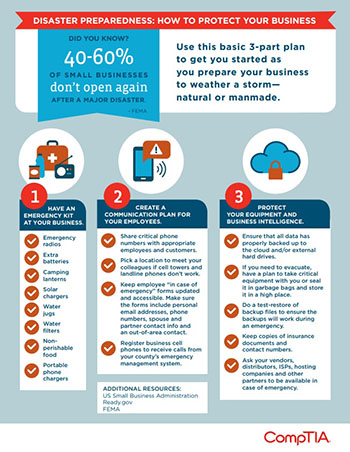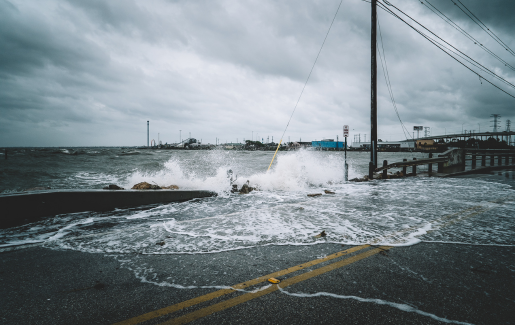.png?sfvrsn=888de9a9_2) Every customer has different expectations, different needs, different goals. That’s never more pronounced than after a disaster or emergency situation has impacted their business.
Every customer has different expectations, different needs, different goals. That’s never more pronounced than after a disaster or emergency situation has impacted their business.
It’s important for solution providers to treat customers accordingly after a disaster—some will need more guidance, some will be patient—but all will turn to their trusted business and IT advisors to get them through the experience, according to several solution providers who survived—and thrived—during natural disasters.
In this second part of a three-part series, we’ll examine advice from solution providers on how to successfully help customers through hurricanes, tornadoes, flooding and other disasters. Part 1 detailed how to manage customers. Part 3 examines lessons the solution providers learned going through disastrous situations
Here are five things solution providers said can help when it comes to managing customers through a disaster:
Start with Communication
Just as its important for solution providers—or any business—to connect with employees before, during and after a disaster, it’s just as important to be able to reach clients, said Vince Gremillion, president of Restech, a Metairie, La.-based solution provider that lived through Hurricane Katrina in 2005.
Solution providers need to assess each client’s damage and then prioritize their resources to help those most in need. “We ask all our clients, what are your plans? How can we reach you? Here’s how you can reach us,” Gremillion said.
That communication also extends up the supply chain to distributors and vendors who may be needed to bring in new equipment and services as soon as possible.
“Vendors do heroes’ work during those situations. After Katrina, they flew in gear, helped us set it up and said we’ll worry about compensation later,” he said. “If you have good relationships with vendors and distributors, ask them to be ready to help. “
Let Customers Know They Matter
If disaster strikes, customers want to know they’ll be taken care of—that they’re important and that they matter to you as their trusted business and IT partners. All of them will want help—and many will expect it right away. But some will require more help—and immediately. You’ll need to prioritize your response based on your customer’s needs but also their value to your organization. It’s important to assign resources to all accounts and have those resources stay in contact with those accounts, said Perrier.
“Identify who will be your first responders and notify all customers that the company will contact them. You should provide them with a comfortable number of contacts to be sure they can contact someone,” said Jim Perrier, CEO of Universal Data, a New Orleans-based solution provider during Hurricane Katrina.
 Eliminate Fear
Eliminate Fear
When disaster has struck, it’s critical for customers to know that things their data and IT isn’t last forever, that systems will come back online and that the business isn’t over, said John Motazedi, president of SNC Squared, which had its office destroyed by a tornado in 2011 in Joplin, Mo.
“You need to quench that fear that things are gone,” Motazedi said.
When a customer has no power or network or anything related to IT, they don’t care that you may have 50 other customers without power or servers too. They’re only worried about their own business right then, he added.
“It’s tough. Certain clients might be more critical or might have more severe issues. Communicate with all of them and give them the real truth on what to expect and why. You don’t want clients to be upset with you on how you performed,” Motazedi said.
SNC’s challenge after the 2011 tornado was half his clients lost everything, half weren’t affected at all. They wanted business as usual. The solution provider dedicated a couple of engineers to handle those clients, while the rest continued on handling customers impacted by the tornado.
“Be patient and do the best you can, trying to set expectations along the way,” Motazedi said.
Customers Are Family Too
After Tropical Storm Lee flooded one-third of Bloomsburg, Pa., in 2011, Fred Reck, president of InnoTek Consulting, did what he would have done for anyone close to him.
“The first thing we wanted to do was make sure we distribute bottled water to clients. We had cases of water that we left at office sites where cleanup was underway,” Reck said. “In situations like that, the human factor becomes important. Everybody needs to be taken care of and thought about on that level first. We start with the human factor, then we start talking about business.”
That family-oriented approach should predate any emergency situation, Reck added. It’s important for solution providers to sit down with clients, talk strategy, and get to know the customers on a deeper level too.
“We talk about their goals. We talk about business continuity. We talk about a lot of things. That helps to establish how to respond in the event of an emergency,” Reck said.
Disaster Can Strike Anywhere, Any Time
eMazzanti was severely impacted by Hurricane Sandy in 2012, but it wasn’t the first time the Hoboken, N.J.-based solution provider had to manage clients through a disaster. CEO Jennifer Mazzanti and president and chairman Carl Mazzanti were both in the World Trade Center to visit clients on Sept. 11, 2001, when the Twin Towers were attacked by terrorists. They crawled out of a broken window to escape before the towers fell. The attack disrupted communications in lower Manhattan for weeks.
“Before 9/11, offsite/hosted backup was such an abstract concept to talk about, but afterwards people wanted to have that conversation and develop plans to get back online quickly,” Jennifer Mazzanti said.
While the technology continues to change, the basic premise of disaster recovery—businesses need to be prepared for a disaster that can strike anywhere and at any time—remains the same, she added.
“It’s a conversation for the future too. To date, these have been ‘livable’ events, but what happens if an area no longer becomes habitable. There are areas that might not come back. What happens when you can no longer remain in the same space and you have to be 100% mobile. That’s what we’re looking at now. What are your options when staying put is no longer an option? Those are conversations to have with customers. You will get judged by clients on how you perform in an emergency. We felt after both Sandy and the 9/11 attacks, clients were more loyal because of our response.”
For more information, consider this checklist of how to prepare for, and survive, a hurricane or other emergency situation.

 Add CompTIA to your favorite RSS reader
Add CompTIA to your favorite RSS reader

